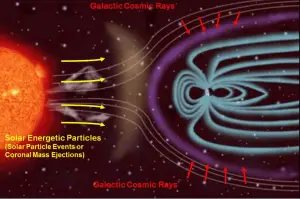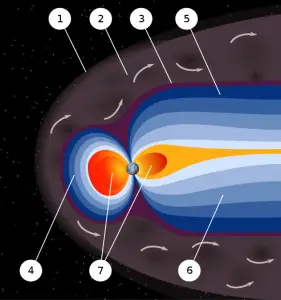
Galactic cosmic radiation, GCR, refers to sources of radiation in the form of high-energy particles originating outside the solar system. GCR are high-energy nuclei from which all of the surrounding electrons have been stripped away during their high-speed passage through the galaxy. The GCR incident on the upper atmosphere consist of a nucleonic component, which aggregate accounts for 98% of the total (2% are electrons). The nucleonic component then consist of a mixture of high-energy protons (~86%), alpha particles (~12%), and a trace of heavier nuclei (~1%). GCR are trapped by the galactic magnetic field, therefore they have probably been accelerated within the last few million years, and have traveled many times across the galaxy. Their acceleration mechanism is uncertain, but one of possible mechanisms is that the particle are accelerated by shock waves expanding from supernovas. The energy of these particles range between 108 eV and 1020 eV. A very small fraction are stable particles of antimatter, such as positrons or antiprotons.
The precise nature of this remaining fraction is an area of active research. The GCR fluence rate varies with solar activity, being lower when solar activity is higher. At solar minimums, due to lower solar magnetic field shielding, the fluence is significantly higher than at solar maximum.
Shielding of Cosmic Radiation

Earth’s magnetic field provides a vital radiation shield of cosmic radiation. In addition to a protective atmosphere, we are also lucky that Earth has a magnetic field. Magnetic field extends several tens of thousands of kilometers into space, protecting the Earth from the charged particles of the solar wind and cosmic rays that would otherwise strip away the upper atmosphere, including the ozone layer that protects the Earth from harmful ultraviolet radiation. It shields us from the full effects of the solar wind and GCR. Without this protection, Earth’s biosphere might not exist as it does today, or would be at least limited to the subsurface. Earth’s magnetic field provides also a radiation shield for astronauts and the ISS itself, because it is in low Earth orbit.
Calculations of the loss of carbon dioxide from the atmosphere of Mars, resulting from scavenging of ions by the solar wind, indicate that the dissipation of the magnetic field of Mars caused a near total loss of its atmosphere.
We hope, this article, Galactic Cosmic Radiation – GCR, helps you. If so, give us a like in the sidebar. Main purpose of this website is to help the public to learn some interesting and important information about radiation and dosimeters.